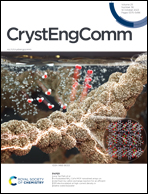Single-crystal growth of layered metallic materials of TiTe2 based on a polytelluride flux method†
Abstract
Layered metallic transition metal dichalcogenides (TMDs) with bonding-free surfaces and weak Fermi-level pinning properties have exhibited potential application as electrode materials in two-dimensional (2D) semiconductor devices. However, various TMDs metallic materials are still limited in certain areas, especially due to the lack of a low-work function (<4.5 eV) counterpart. Herein, we report a polytelluride flux growth method for TiTe2 single crystals and determine the work function of this IVB group metallic TMD for the first time. The obtained crystal adopts a typical 1T-type structure (P![[3 with combining macron]](https://www.rsc.org/images/entities/char_0033_0304.gif) m1 space group, no. 164) with the lattice parameters a = 3.7668(4) Å and c = 6.4918(10) Å. The TiTe2 crystal showed metallic behavior with decreased resistivity upon cooling and a relatively low resistivity value (4.39 × 10−4 Ω cm) at room temperature. By ultraviolet photoelectron spectroscopy, the work function of TiTe2 was determined as 4.31 eV, which is much smaller than the reported data of other metallic TMDs. Our study demonstrates the interesting work function data of 1T-TiTe2, which can be utilized to make excellent metal–semiconductor contacts in 2D semiconductor devices.
m1 space group, no. 164) with the lattice parameters a = 3.7668(4) Å and c = 6.4918(10) Å. The TiTe2 crystal showed metallic behavior with decreased resistivity upon cooling and a relatively low resistivity value (4.39 × 10−4 Ω cm) at room temperature. By ultraviolet photoelectron spectroscopy, the work function of TiTe2 was determined as 4.31 eV, which is much smaller than the reported data of other metallic TMDs. Our study demonstrates the interesting work function data of 1T-TiTe2, which can be utilized to make excellent metal–semiconductor contacts in 2D semiconductor devices.



 Please wait while we load your content...
Please wait while we load your content...